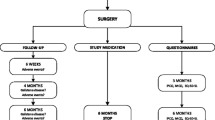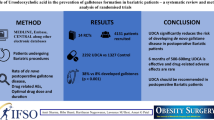Opinion Statement
The combination of statin drugs with ursodiol for the dissolution of cholesterol gallstones may be more effective than monotherapy alone. Adding a statin drug that inhibits HMG-CoA reductase may reduce biliary cholesterol so that the combination with ursodiol produces the maximum decrease in biliary cholesterol secretion. The major disadvantage is the added cost of using two drugs.
Similar content being viewed by others
References and Recommended Reading
Holan KR, Holzbach RT, Hermann RE, et al.: Nucleation time: a key factor in the pathogenesis of cholesterol gallstone disease. Gastroenterology 1979, 77:611–617.
Halpern Z, Dudley MA, Lynn MP, et al.: Vesicle aggrega-tion in model systems of supersaturated bile: relation to crystal nucleation and lipid composition of the vesicular phase. J Lipid Res 1986, 27:295–306.
Small DM: Cholesterol nucleation and growth in gall-stone formation. N Eng J Med 1980, 302:1306–1307.
Hussaini SH, Pereira SP, Murphy GM, Dowling RH: Deoxycholic acid influences cholesterol solubilization and microcrystal nucleation time in gallbladder bile. Hepatology 1995, 22:1735–1744.
Hofmann AF: Medical treatment of cholesterol gallstones by bile desaturating agents. Hepatology 1984, 4:199S-208S.
Einarsson K, Grundy S: Effects of feeding cholic acid and chenodeoxycholic acid on cholesterol absorption and hepatic secretion of biliary lipids in man. J Lipid Res 1980, 21:23–34.
Cooper J, Geizeroua M, Oliver M: Clofibrate and gallstones. Lancet 1975, 1:1083.
Coronary Drug Project Research Group. Gallbladder diseases as a side effect of drugs. N Eng J Med 1977, 296:1185.
Grundy SM: HMG-CoA reductase inhibitors for treatment of hypercholesterolemia. N Eng J Med 1988, 319:24–33.
Duane WC, Hunninghake DB, Freeman ML, et al.: Simvastatin, a competitive inhibitor of HMG-CoA reductase, lowers cholesterol saturation index of gallbladder bile. Hepatology 1988, 8:1147–1150.
Saunders KD, Cates JA, Abedin MZ, et al.: Lovastatin inhibits gallstone formation in the cholesterol fed prairie dog. Ann Surg 1991, 214:149–153.
Saunders KD, Cates JA, Abedin MZ, Roslyn JJ: Lovastatin and gallstone dissolution: a preliminary study. Surgery 1993, 113:28–35.
Smit JWA, Erpecum KJV, Stock MFJ, et al.: Successful dissolution of cholesterol gallstones during treatment with pravastatin. Gastroenterology 1992, 103:1068–1070.
Bazzoli F, Mazzella G, Zagari RM, et al.: HMG-CoA reductase inhibitors lower biliary cholesterol saturation but are ineffective cholesterol gallstone dissolving agents. Gastroenterology 1992, 102:A302.
Sharma BC, Agarwal DK, Baijal SS, Saraswat VA: Pravastatin has no effect on bile lipid composition, nucleation time, and gallbladder motility in persons with normal levels of cholesterol. J Clin Gastroenterol 1997, 25:433–436. The authors report the inability of statins to lower biliary choles-terol saturation in normolipidemic subjects, which may limit the applicability of statins only in hypercholesterolemic subjects.
Smit JWA, van Erpecum KJ, Renooli W, et al.: The effects of the 3-hydroxy, 3-methylglutaryl coenzyme: a reduc-tase inhibitor pravastatin on bile composition and nucleation of cholesterol crystals in cholesterol gallstone disease. Hepatology 1995, 21:1523–1529. The authors conclude that pravastatin may be ineffective in cholesterol gallstone solubilization.
Tazuma S, Takizawa I, Kunita T, et al.: Effects of long-term treatment with low-dose pravastatin on biliary lipid and bile acid composition in patients with hyperlipo-proteinemia. Metabolism 1995, 44:1410–1412.
Chapman BA, Burt MJ, Chisholm RJ, et al.: Dissolution of gallstones with simvastatin, an HMG CoA reductase inhibitor. Dig Dis Sci 1998, 43:349–353.
Schwartz CC, Berman M, Vlahcevic ZR, Swel L: Multicompartmental analysis of cholesterol meta-bolism in man: a quantitative kinetic evaluation of precursor sources and turnover of high density lipopro-tein cholesterol esters. J Clin Invest 1982, 70:864–878.
Mazzella G, Parini P, Festi D, et al.: Effect of simvasta-tin, ursodeoxycholic acid and simvastatin plus ursodeoxycholic acid on biliary lipid secretion and cholic acid kinetics in nonfamilial hypercholester-olemia. Hepatology 1992, 15:1072–1078.
Podda M, Zuin M, Dioguardi ML, et al.: A combination of chenodeoxycholic acid and ursodeoxycholic acid is more effective than either alone in reducing biliary cholesterol saturation. Hepatology 1982, 2:334–339.
Logan GM, Duane WC: Lovastatin added to urso-deoxycholic acid further reduces biliary cholesterol saturation. Gastroenterology 1990, 98:1572–1576.
Tazuma S, Kajiyama G, Mizuno T, et al.: A combination therapy with simvastatin and ursodeoxycholic acid in more effective for cholesterol gallstone dissolution than is ursodeoxycholic acid monotherapy. J Clin Gastroenterol 1998, 26:287–290. The authors have compared the effectiveness of statin added to ursodeoxycholic acid for gallstone dissolution in hypercho-lesterolemic subjects and find the combination therapy to be significantly more effective for dissolution of multiple stones.
Muraca M, Baggio G, Vilei MT, et al.: Effect of with-drawal of pravastatin on biliary lipid composition in humans. Atherosclerosis 1996, 123:133–137. The authors have addressed an important issue of the effect of withdrawal of statin treatment. In this very short-term study, they find that sudden withdrawal of statin increases biliary cholesterol secretion and hence, they recommend gradual withdrawal from the drug. The authors rightly caution that the drug withdrawal effect may be more severe in patients who have been taking statins for long periods of time, which may be the usual case, since these drugs are primarily used for lowering cholesterol.
Author information
Authors and Affiliations
Rights and permissions
About this article
Cite this article
Salen, G., Batta, A.K. Medical therapy for cholesterol-gallstones: A role of statins?. Curr Treat Options Gastro 2, 337–341 (1999). https://doi.org/10.1007/s11938-999-0011-8
Issue Date:
DOI: https://doi.org/10.1007/s11938-999-0011-8




